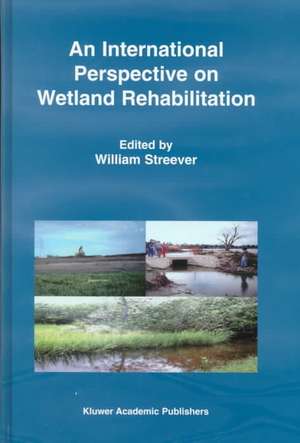An International Perspective on Wetland Rehabilitation
Editat de W.J. Streeveren Limba Engleză Hardback – 31 iul 1999
| Toate formatele și edițiile | Preț | Express |
|---|---|---|
| Paperback (1) | 947.18 lei 6-8 săpt. | |
| SPRINGER NETHERLANDS – 29 oct 2012 | 947.18 lei 6-8 săpt. | |
| Hardback (1) | 953.20 lei 6-8 săpt. | |
| SPRINGER NETHERLANDS – 31 iul 1999 | 953.20 lei 6-8 săpt. |
Preț: 953.20 lei
Preț vechi: 1162.43 lei
-18% Nou
Puncte Express: 1430
Preț estimativ în valută:
182.42€ • 198.08$ • 153.23£
182.42€ • 198.08$ • 153.23£
Carte tipărită la comandă
Livrare economică 22 aprilie-06 mai
Preluare comenzi: 021 569.72.76
Specificații
ISBN-13: 9780792357247
ISBN-10: 0792357248
Pagini: 338
Ilustrații: IX, 338 p.
Dimensiuni: 170 x 244 x 21 mm
Greutate: 0.67 kg
Ediția:1999
Editura: SPRINGER NETHERLANDS
Colecția Springer
Locul publicării:Dordrecht, Netherlands
ISBN-10: 0792357248
Pagini: 338
Ilustrații: IX, 338 p.
Dimensiuni: 170 x 244 x 21 mm
Greutate: 0.67 kg
Ediția:1999
Editura: SPRINGER NETHERLANDS
Colecția Springer
Locul publicării:Dordrecht, Netherlands
Public țintă
ResearchCuprins
Section 1: Regional Overviews.- 1. Compensatory Wetland Mitigation in the Commonwealth of the Northern Mariana Islands: An Incipient Discipline.- 2.Wetland Rehabilitation in Australasia.- 3. Mangrove Rehabilitation in the Coastal Mekong Delta.- 4. Mangrove Rehabilitation in the Philippines.- 5. Rehabilitation of Wetlands: An African Perspective.- 6. Wetland Rehabilitation in the Mediterranean Basin.- 7.Central European Perspectives in Lake Shore Rehabilitation.- 8. Putting Policy into Practice in South West England.- 9. Wetland Rehabilitation in the Caribbean.- Section 2: Case Studies.- 10. Rehabilitating Wyndgate: Bringing Back Wetlands on a Family Property in South Australia.- 11. Saltwater Intrusion and the Mary River Wetlands of the Northern Territory.- 12. Effective Planning and Community Consultation: the Big Swamp Urban Wetland Rehabilitation Project, City of Bunbury, Western Australia.- 13. Moanatuatua Bog—Proposed Restoration of a New Zealand Restiad Peat Bog Ecosystem.- 14. Local Community Involvement in Mangrove Rehabilitation:Thailand’s Yadfon.- 15. Prescribed Flooding and Wetland Rehabilitation in the Zambezi Delta, Mozambique,.- 16. Management of the Alien Weed, Salvinia molesta, in the wetlands of the Okavango, Botswana.- 17. Conservation and Rehabilitation of Lake Kanyaboli Wetland, Kenya.- 18. The Hula Valley (Northern Israel) Wetlands Rehabilitation Project.- 19. Ecology and Politics of Rehabilitation: Mogan Lake Wetland Ecosystem, Ankara, Turkey.- 20. Restoration Prospects of Degraded Lowland Brook Valleys in The Netherlands: An Example from the Gorecht Area.- 21. Rehabilitation Following Industrial Contamination: Jaua Lake, a Coastal Wetland in Camacari, Bahia, Brazil.- 22. Restoration of High Latitude Wetlands: An Example from the Canadian HighArctic.- Section 3: Issues in Rehabilitation.- 23. Valuing Wetland Rehabilitation.- 24. Revegetation Strategies for Northern Temperate Glacial Marshes and Meadows.- 25. The Consulting Industry in Wetland Rehabilitation.- 26. Wetland Rehabilitation and Remote Sensing.- 27. Ecological Theory and Its Role in the Rehabilitation of Wetlands.- 28. Disused Shrimp Ponds and Mangrove Rehabilitation.- Section 4: Putting Rehabilitation into Perspective.- 29. The Ecological Restoration Spectrum.- 30. Constraints to Successful Rehabilitation of Subtropical and Tropical Wetlands.
Recenzii
`This edited volume paints, in remarkable detail, the broad spectrum of wetland rehabilitation efforts world-wide, at the same time illustrating the ecological principles that operate in wetlands and affect wetland response to conservation efforts.'
Jan Keough, President, Society of Wetland Scientists
`In the words of one of the authors, much of the most valuable data on wetland rehabilitation never gets published. This volume brings together data and analyses of wetland rehabilitation from around the world. It will be invaluable to practicing wetland scientists.'
John Teal, author of Life and Death of the Salt Marsh
`An International Perspective on Wetland Rehabilitation is a timely addition to wetlands literature. Wetland managers, scientists and practitioners around the world will find this publication provides a very useful insight into wetland restoration and creation at the international level.'
Kevin L. Erwin, Ecologist and Wetland Restoration Specialist, Group Coordinator for Wetlands International
`This is an excellent book, with an excellent collection and selection of material covering the most significant aspects of wetland rehabilitation on a worldwide scale. It demonstrates that no universal strategy or decision which may be succesfully applied to wetland rehabilitation in different natural, environmental and socio-economic conditions can be established. Nevertheless, the book provides invaluable information for environmental scientists, managers, engineers, planners and decision-makers, students and the general public. It contributes significantly to the more thorough understanding of various aspects of the wetland rehabilitation problem, as well as to promoting the international exchange of information and experience concerning wetland rehabilitation.'
Bulletin, 50:4 (2001)
Jan Keough, President, Society of Wetland Scientists
`In the words of one of the authors, much of the most valuable data on wetland rehabilitation never gets published. This volume brings together data and analyses of wetland rehabilitation from around the world. It will be invaluable to practicing wetland scientists.'
John Teal, author of Life and Death of the Salt Marsh
`An International Perspective on Wetland Rehabilitation is a timely addition to wetlands literature. Wetland managers, scientists and practitioners around the world will find this publication provides a very useful insight into wetland restoration and creation at the international level.'
Kevin L. Erwin, Ecologist and Wetland Restoration Specialist, Group Coordinator for Wetlands International
`This is an excellent book, with an excellent collection and selection of material covering the most significant aspects of wetland rehabilitation on a worldwide scale. It demonstrates that no universal strategy or decision which may be succesfully applied to wetland rehabilitation in different natural, environmental and socio-economic conditions can be established. Nevertheless, the book provides invaluable information for environmental scientists, managers, engineers, planners and decision-makers, students and the general public. It contributes significantly to the more thorough understanding of various aspects of the wetland rehabilitation problem, as well as to promoting the international exchange of information and experience concerning wetland rehabilitation.'
Bulletin, 50:4 (2001)







